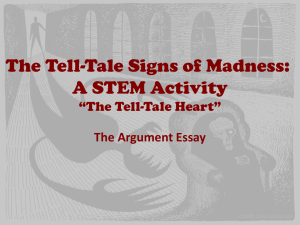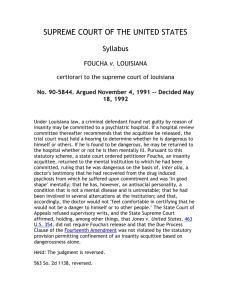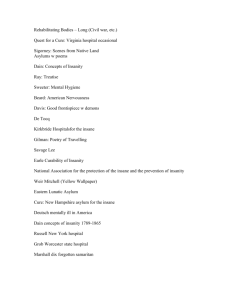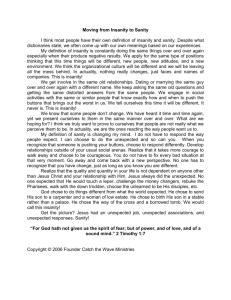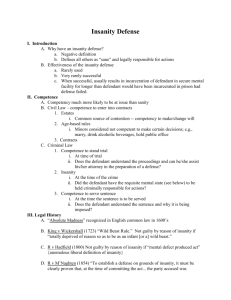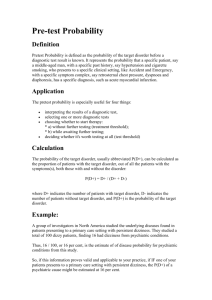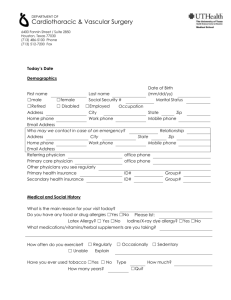Forensic Psychiatry - MBBS Students Club
advertisement
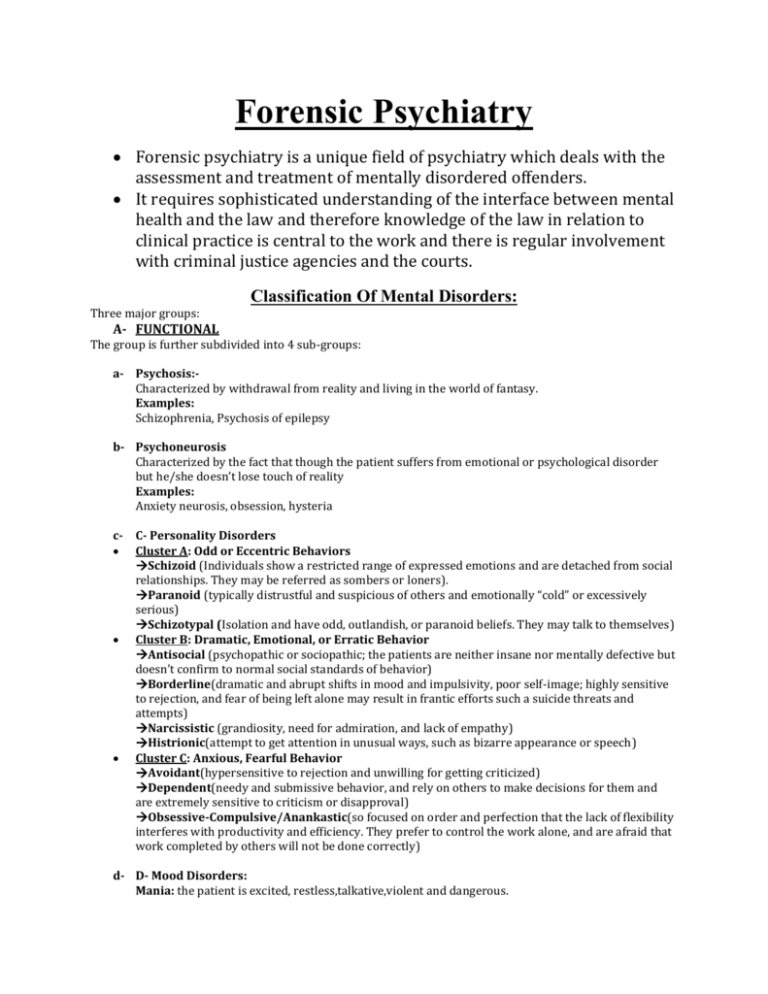
Forensic Psychiatry Forensic psychiatry is a unique field of psychiatry which deals with the assessment and treatment of mentally disordered offenders. It requires sophisticated understanding of the interface between mental health and the law and therefore knowledge of the law in relation to clinical practice is central to the work and there is regular involvement with criminal justice agencies and the courts. Classification Of Mental Disorders: Three major groups: A- FUNCTIONAL The group is further subdivided into 4 sub-groups: a- Psychosis:Characterized by withdrawal from reality and living in the world of fantasy. Examples: Schizophrenia, Psychosis of epilepsy b- Psychoneurosis Characterized by the fact that though the patient suffers from emotional or psychological disorder but he/she doesn’t lose touch of reality Examples: Anxiety neurosis, obsession, hysteria c- C- Personality Disorders Cluster A: Odd or Eccentric Behaviors Schizoid (Individuals show a restricted range of expressed emotions and are detached from social relationships. They may be referred as sombers or loners). Paranoid (typically distrustful and suspicious of others and emotionally “cold” or excessively serious) Schizotypal (Isolation and have odd, outlandish, or paranoid beliefs. They may talk to themselves) Cluster B: Dramatic, Emotional, or Erratic Behavior Antisocial (psychopathic or sociopathic; the patients are neither insane nor mentally defective but doesn’t confirm to normal social standards of behavior) Borderline(dramatic and abrupt shifts in mood and impulsivity, poor self-image; highly sensitive to rejection, and fear of being left alone may result in frantic efforts such a suicide threats and attempts) Narcissistic (grandiosity, need for admiration, and lack of empathy) Histrionic(attempt to get attention in unusual ways, such as bizarre appearance or speech) Cluster C: Anxious, Fearful Behavior Avoidant(hypersensitive to rejection and unwilling for getting criticized) Dependent(needy and submissive behavior, and rely on others to make decisions for them and are extremely sensitive to criticism or disapproval) Obsessive-Compulsive/Anankastic(so focused on order and perfection that the lack of flexibility interferes with productivity and efficiency. They prefer to control the work alone, and are afraid that work completed by others will not be done correctly) d- D- Mood Disorders: Mania: the patient is excited, restless,talkative,violent and dangerous. Melancholia/Depression: loss of interest in normal activitiesrefusal of food, lack of personal attwntion and suicidal tendencies B- ORGANIC In these disorders brain tissue is physically involved leading to permanent or temporary dysfunction of the brain Causes:- Arteriosclerosis, neuropathy, neoplasm, injury, scarring, hemorrhage Examples:Brain injury caused by trauma, Alzheimer's disease, Huntington's disease, Multiple sclerosis, Parkinson's disease, Alcohol withdrawal state, Vitamin deficiency (B1, B12, or folate) and etc C- TOXIC / METABOLIC Insanity associated with : Use of alcohol, cannabis indica, barbiturate etc Exposure to toxic chemicals like lead, cyanide and etc Some Important Definitions Delusion: A false or firm belief in something, which is not a fact and is out of context with the person’s educational and cultural background Not an isolated disorder and indicate deep-seated widespread disorder such as Schizophrenia and GPI. Types: 6:1- Hypochondrial Such delusions are severe fixed thoughts of bodily change due to an illness which is not actually proven by any objective investigstions, examination or tests. 2- Nihilistic Ideas that his body or organ does not exist or the world is coming to an end or does not exist all 3- Depressive Morbid thoughts of guilt, self-blame or futility of life 4- Infidelity Ideas of cheating, adultery, or having an affair of some loved one with anyone other than him/her 5- Grandiose Thoughts of over-estimation of personal qualities, abilities, and finances (as those occurring in hypomanic illness) may be subtle if the background of the patient is not known 6- Paranoid Ideas of persecution and injustice incurred on the patient from others out of hatred or jealousy of his/her personal talents or special abilities or for no clear reason. 7- Passivity Patients believe there are abnormal influences on their bodily processes by outside agencies 8- Reference Patient believes they are the center of excessive focus of attention from others, and they are referred to in other’s speech, thoughts or remarks Illusion: A false interpretation of an external object or stimulus, which has a real existence Illusions of sight, hearing and other senses may occur Examples:- Mistaking stick as snake, dog as lion, tree as ghost etc Hallucination: False perception without sensory stimulus It means seeing, hearing, smelling, tasting or touching something which is not actually present Types: 4:1- Visual 2- Auditory 3- Olfactory/Gustatory 4- Tactile Obsession: A thought, image, feeling or movement which an individual feels and compelled to carry out usually repetitively, in spite of a strong urge to resist Examples:- Fear of open or closed spaces, animals etc Automatism: Performance of actions without conscious thought or intention May be a product of disease (epilepsy), external factors (concussion), psychological stress (hysteria) or drugs (barbiturates, alcohol) Confabulation : A pathological loss of memory in which the patient fills the gaps with purely imaginary events. These fabrications are called confabulation. Delerium: An acute confusional state characterised by cloulding of consciousness, disoriention, incoordination and abnormal experiences such as hallucination, delusion and illusion lasting from a few hours to days and weeks and ends with full or varying degree of recovery. For example drug or alcohol intoxication or withdrawl , head injury, metabolic upset s or mental stess. The patient is therefore often impulsive and may commit sucide or some violent act. Fugue: This is a disturbed state of consciousness in which the affected person performs acts of which he appears to be consious but of a which on recovery he has no recollection. It is encountered in a dissociative disorder( hysteria) and epilepsy. Neurosis: The patient suffers from emotional or intellectual disorder but does not lose touch with reality. Stupor : A state of complete suppression of speech, movement and action not accounted for, by profound disturbances of conciousness. Common in schizophrenia,depression,hysteria,epilepsy,metabolic upset,opium poisoning and certain diseases of CNS Twilght state: Conditons of diminised awareness of relatively short duration during which the patient may carry out actions of which he has little no subsequent memory Occurs in hysteria and epilepsy Dementia: Decline of intellectual function of memory, comprehension and reasoning ablity and emotional changes Types three 1-Organic Due to some diseease of brain Restlessness ,irratability and delerium progressive mental deterioration with marked memory loss, disorientation in time place and person and general childishness 2-Senile Caused by onset of old age and cerebral arteriosclerosis Memory loss and childish and perverted in bahaviour 3-Dementia Paralytica/GPI Loss of interest,negligence, loss of control of sex instense and violent bahiour Mentally Ill Person: A person who is in need of treatment by reason of any mental disorder other than mental retradation. Non-Compos Mentis Means Person of unsound mind A magistrate/judge may probe into whether the person before court is mentally sound or not and can order his/her psychiatric exam Diagnosis An RMP in order to diagnose mental illness in a patient must follow in detail the following steps:1-Family History 2-Personal History 3-Physical Examination 4-Mental Condition General appearance and behaviour, gait, talk,mannaers and content,subject statecontent of thoughts, perception, contact with reality, sensoriun and formal intelligence, insight and judgement, handwriting 5-Lab Investigations:- Blood and urine tests, CSF Exam,EEG Insanity a-Legal Insanity Patient suffers from a serious and certifiable mental illness Difference between :- a- Legal / True Insane b-Feigned Insane Patient suffers from a serious and certifiable mentalThe assumption of a mental disorder for the Illness. The disorder is sufficient to warrant legalpurposes of evasion, deceit or the diversion of Of the sufferersuspicion Onset is usually gradual and without any motive Onset is sudden with some motive Predisposing cause is usually present Predisposing cause usually not persent Precellular facial expression Normal facial expression S/S of insanity present all the time and particularly S/S of insanity present only when pt is Point to a particular mental illnessobserved and are particularly uniform Pt is usually dirty or filthy and may become violent Not usually dirty but may give a false for several hrs/days without exhaustion impression of being dirty and amay get exhausted after a short episode of violent behaviour Examined once May be examined repeatedly b-Impulsive Insanity Sudden and irresistible force compelling the person to the conscious performance of acts without motive or forethought, e.g., a mentally sound person may not put his finger in fire while an insane may put his finger in fire due to irresistible impulse Types:-Klepto-Mania:-Stealing articles of little value Pyro-Mania:-Setting fire to things Multilo-Mania:-Maiming animals/lame Sexual-Mania. Lucid Interval: In course of a mental disease, the period during which there is complete cessation of symptoms of insanity and the patient can judge his acts soundly and legally responsible for his deeds, make a valid statement and can give a valid evidence MC’ Naughten’s Rule -To establish defense on grounds of insanity, it must be shown clearly that: At time of committing the act, the accused was laboring under such defect of reason, from disease of mind as not to know the nature and quality of what he was doing, OR, At time of committing the act, the accused was laboring under such defect of reason, from disease of mind as not to know that whatever he was doing was right or wrong -Limitation: Psychiatrists thought that emphasis is on reason as the main factor in determining an individual’s behavior while ignoring the potent effect of emotions, delusions, belief and hallucinations Durham’s Formula Accused is not criminally responsible if his unlawful act was the product of mental disease or mental defect. Testamentary Capacity Testamentary capacity refers to the ability of a person to make a valid will. Law defines it as compose-mentis which must be confined by a doctor For a will to become valid, the testator must: Be a major Have a sound disposing mind at the time of making a will Understand the nature and consequences of his act Know what property he has, to whom and why he is giving his property Execute it voluntarily and without any undue influence by any other person Sign the will in the presence of two trustworthy witnesses out of which one must be a doctor and none of the witnesses should be a beneficiary from the will To invalidate a will on the ground of insanity of the testator, it must be proved that at the time of making of will the testator was mentally incapacitated to a certain extent so that: He didn’t know the nature of his act Was not fully aware of consequences Had made the disposal of property which he didn’t have Section 59 Of Succession Act Every major person of sound mind may dispose his property by will. An insane may make a will during the Lucid Interval. Presence of sound mind usually depends upon the ability to:-Make true and factual mental perception about his/her property -Form a rational judgement -Exercise the will power in accordance with rational thinking -Make the will without any undue influence by any other person The doctor determines that whether the person is in sense or not or whether he is under the effect of some drug or not
